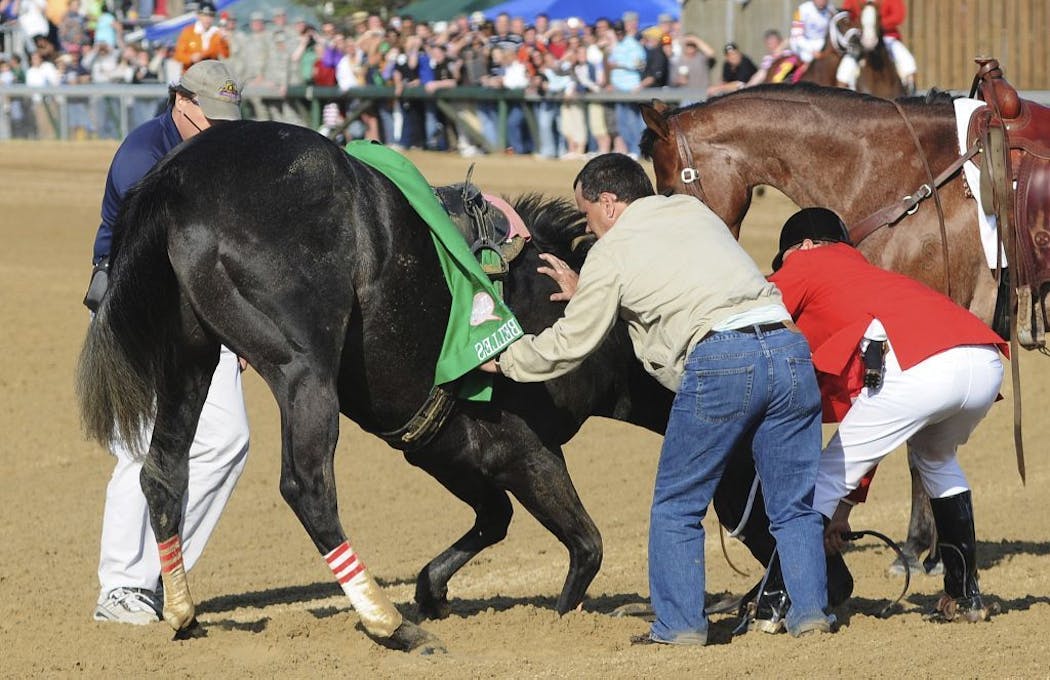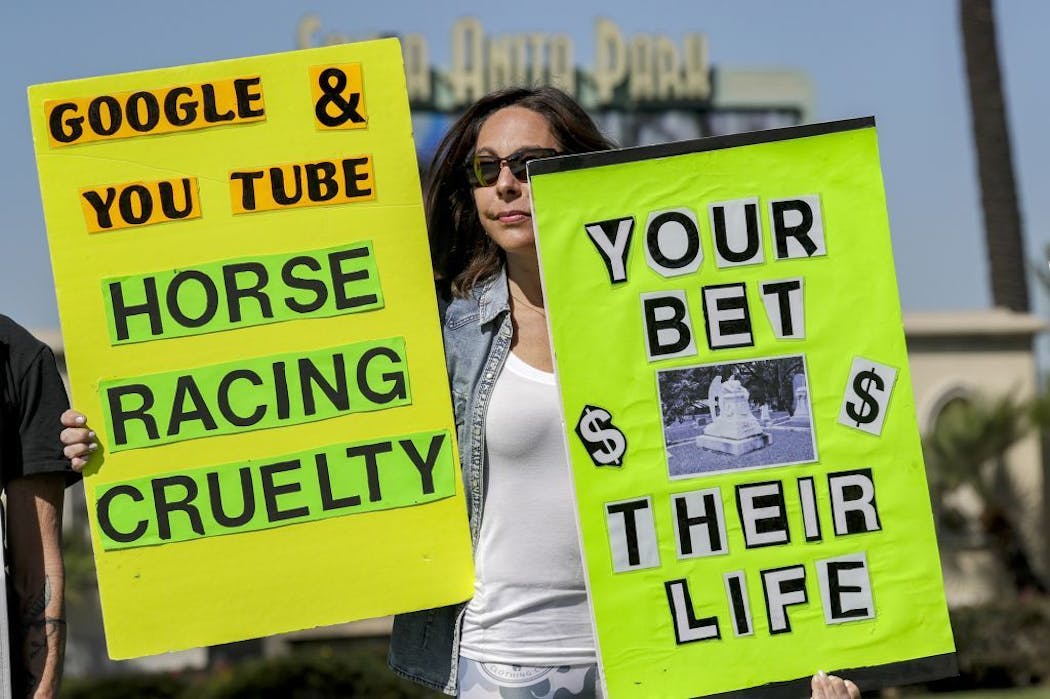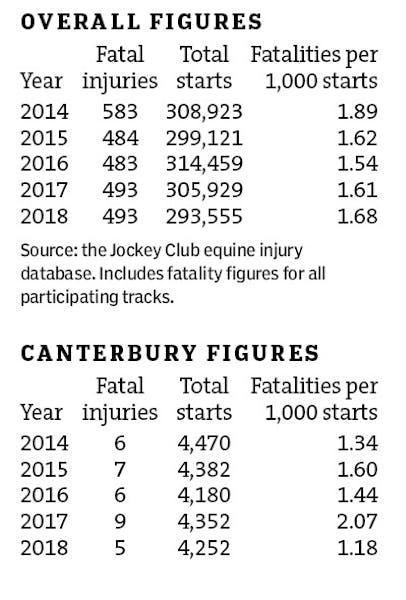Battle of Midway, Princess Lili B and Arms Runner had never raced at Canterbury Park, save for an occasional appearance on the track's simulcast screens. The three thoroughbreds were running under the winter sun of Southern California when they died earlier this year, joining the list of 23 racehorses that have suffered fatal injuries at Santa Anita Park.
The toll of those bleak 96 days, though, has been felt all over the country — including in Shakopee, where Canterbury Park will begin its 25th racing season Friday.
"It's very concerning for everyone in the industry," said Scott Rake, a racehorse breeder from Elko New Market. "Anybody that says they don't have concerns about the sport is naive or misinformed."
Heading into Kentucky Derby week, the sudden spike in fatalities at Santa Anita has reignited debate about whether horse racing is doing enough to protect its equine athletes' health. After years of piecemeal efforts to enhance safety, the industry is feeling fresh urgency to solve an issue that has alarmed its fans and inflamed its foes.
Among thoroughbreds, the rate of fatal breakdowns — racing's term for major injuries suffered on the track — was 1.68 per 1,000 race starts in 2018. Horses are typically euthanized after catastrophic leg injuries because they cannot recover from such severe damage.
The national fatality rate has declined 16% since 2009, but reducing those numbers further has proved difficult in a fractured, tradition-bound sport.
At Canterbury, five horses died during last summer's 69-day racing season. Though its rate of 1.18 is well below the national average, track officials and the Minnesota Racing Commission have added more safety measures this year, including a $100,000 renovation of the track surface and an increase in out-of-competition drug tests for horses.
Canterbury President Randy Sampson called the Santa Anita deaths "a wake-up call" for racing, which is under heavy public scrutiny. U.S. Sen. Dianne Feinstein (D-Calif.) has asked the California Horse Racing Board to suspend racing at Santa Anita while the deaths are investigated. The Los Angeles district attorney's office has opened an investigation, while animal-rights activists in the state are advocating for a ballot initiative to ban horse racing.
Even the Jockey Club, one of the industry's oldest and most influential organizations, warned last month that "the future of the sport will continue to wane" unless it accepts significant reforms.
"Nobody knows how this is going to turn out, or how we'll get through this period," Sampson said. "The best thing we can do is just keep doing everything we can to protect horses and make it as safe as we can for them.
"Our goal is zero breakdowns. I know we're not likely to achieve it, but that has to be the goal."
Rethinking track safety
The fatalities at Santa Anita, one of America's most storied racetracks, happened during the first 14 weeks of a season that began Dec. 26. The Los Angeles-area track canceled racing for 24 days in March while investigators searched for answers. Shortly after it reopened, another horse was euthanized after suffering catastrophic leg injuries.
No cause has been announced, but speculation has focused on the racing surface, which might have been affected by an unusually cold and rainy winter. Dr. Lynn Hovda, chief veterinarian for the Minnesota Racing Commission, said it's likely more complicated than that.
"I think the racing surface has played a part," she said. "But I think you need to look at the number of times and number of furlongs of high-speed workouts. I don't know if medication played a part or not. There are usually multiple factors."
Issues that can contribute to breakdowns include a track surface with poor cushion or consistency; failure to give horses enough rest; drugs that can mask pain or interfere with bone development; running horses that aren't fit; and pushing tired animals past their limits. Some leg injuries can be surgically repaired. But because a horse's legs bear so much weight, complications are common, and the severe damage that happens at race speed is often unfixable.
Santa Anita acted quickly to repair its surface and expand its rules on medication use. The Stronach Group, which owns Santa Anita and several other tracks, is pursuing more changes such as strict limits on whip use, increased out-of-competition drug testing and adding diagnostic equipment to screen horses for pre-existing conditions.
"We have arrived at a watershed moment," Stronach Group Chairman Belinda Stronach wrote in an open letter to the industry on March 14. "We are taking a step forward and saying, quite emphatically, that the current system is broken. … First and foremost, we must do right by the horse."
Canterbury Park has been proactive in working to prevent breakdowns. Its longstanding list of safety practices has kept its fatality rates below the national average most years, including four of the past five. The exception was 2017, when nine deaths occurred.
State veterinarians examine horses multiple times on the day of a race. Necropsies are performed on all horses that break down, with the results passed along to trainers. Minnesota was among the first states to limit whip use, and its drug-testing program is considered stringent by national standards.
The track just completed a full renovation of its racing surface and spent another $130,000 on a new water truck to help maintain it. Tom DiPasquale, executive director of the Minnesota Racing Commission (MRC), said the commission plans to increase out-of-competition drug testing, and it announced tougher new regulations last week regarding some medications. The MRC also hopes to institute fitness exams for horses coming off long layoffs, as well as a continuing education program for trainers.
"We're proud of what we've done, but there's more to do," DiPasquale said. "The industry has to acknowledge that the sport has risk, and do what we can to mitigate it. I'm confident that over time, things will continue to get safer."
Sport's factions unite
Racing has faced similar crises in the past, including the high-profile breakdown of Eight Belles in the 2008 Kentucky Derby. Every time, the industry has discussed ways to reduce fatalities, only to see its efforts hampered by a lack of money and unity.
Horse racing has no national governing organization or nationwide rules. All 38 state racing commissions and the tracks are free to set their own regulations, creating a wide variation in track conditions, safety protocols and minimum standards. Some do very little to ensure horses are healthy and sound.
The sport's many constituencies — including trainers, horse owners, track management and regulatory bodies — often have differing agendas, impeding their ability to work together to solve problems.
"We have a crisis in our industry, brought about by everyone moving in separate directions," DiPasquale said. "It has to be a group effort."
Like many in racing, Canterbury's Sampson believes the sport needs a national oversight commission and a uniform set of rules. Two members of the U.S. House of Representatives have introduced legislation to create a national drug-testing program for racing, but that, too, has been divisive.
There is escalating public pressure for reform. Racing already is struggling to retain fans and attract new ones, and the industry knows it cannot afford to alienate Americans concerned with how animals are treated. After Florida passed a constitutional amendment last year to ban greyhound racing, petition drives have sprung up in California to do the same with horse racing.
Andrew Offerman, Canterbury's director of racing, said the uproar over the Santa Anita fatalities has given new urgency to the task of reducing breakdowns.
"The biggest difference I see is that a lot more people nationally are on the same page, with ideas about what should be done," he said. "In the past, issues like [the Santa Anita deaths] were viewed as isolated incidents. I think the industry has come together in a much different fashion over this latest spike."
Rake, who is president of the group that represents thoroughbred horsemen at Canterbury, said racing is "100 percent capable" of pulling together to insist on a safer sport. To honor the horses that give their all on the track, he wants to see the industry give its all for them.
"I really think the stars are aligning," Rake said. "I'm hopeful that out of this horrible tragedy, we're going to get some meaningful reform.
"Our goal is to never have a breakdown. If that's not our goal, then we're in the wrong sport."
Cavaliers feel better prepared for playoff stage after '23 flop, face Magic in first-round series
Olympic organizers unveil strategy for using artificial intelligence in sports
Former Cooper football star Howard transfers from LSU to Gophers
Chinese Grand Prix could deliver drama to F1 and slow Verstappen's victory march




